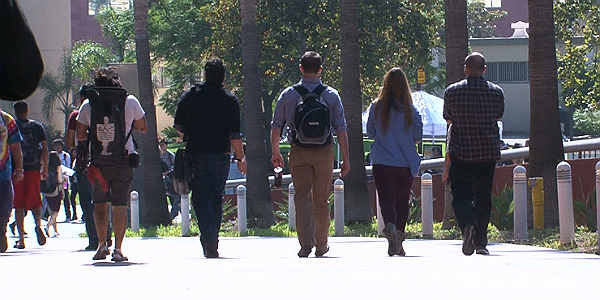
(Photo Credit: John Guenther)
California is most often seen as a “blue state,” meaning the electorate leans toward the Democratic Party both in registration and number of elected officials. And, while it may be true among Generation X, Baby Boomers and the Silent Generation, the increasingly unaffiliated Millennial Generation may turn the state neither red nor blue.
A 2012 study found that nearly 30 percent of millennials who registered identified as “no party preference.” In that same study, released by the California Civic Engagement Project (CCEP) at the UC Davis Center for Regional Change, slightly less than 40 percent of millennials registered Democrat and about 20 percent registered Republican. That means the millennials are the age group with the lowest percentage of registered Democrats and the only group to have more unaffiliated voters than Republicans.
But even though millennials may change the color of California, going by their registration numbers, they are also the lowest voting demographic. The Public Policy Institute of California shows that, although millennials make up 34 percent of the adult population, only 18 percent of them are likely voters.
“Youth are turning to ‘no party preference’ and if that number continues to grow, you’re going to get lower turnout as it becomes a bigger percentage of the youth vote,” said Director of CCEP, Mindy Romero, who studies voting demographics within the state.
The reason for that warning is the CCEP study found that there is a direct correlation between not affiliating with a party and voter turnout.
“We did identify that for every age group, that voters who were registered as ‘no party preference,’ their turnout rates are lower,” added Romero. “That was the case for 2012 and we’ll certainly look at it for 2014.”
Traditionally, the two major political parties play a big role in voter turnout. The political parties spend a lot of time and money sending out voter guides, telemarketing and encouraging their voters cast ballots. Without an affiliation, there are no mailers, no calls and no encouragement.
“There’s lots of work in the political science field to identify the importance of party closeness,” said Romero. “It is not only the main predictors of how we vote, but it also gets us out to the polls. Because parties played a really dominant role in educating and getting people out to the polls.”
So as the numbers of millennials who are unaffiliated voters grow, the dilemma is getting them to vote. One answer is to get more information about the election to them. That is why the League of Women Voters of California Education Fund and MapLight have joined forces to create Voter’s Edge, a website that offers non-partisan information on candidates and propositions. The website allows users to find out basic information about their statewide and local races by just inputting his/her zip code. On it’s October 1 launch, it will also incorporate the LWVC’s Smart Voter guide as well.
Because as Romero explained, “It doesn’t mean that they’re (Millennials) non-political or that they’re rejecting party stands and that sort of thing, it means, at the very least that they are getting less information. And they’re getting less of that motivation.”
So, if this trend continues, what will be the color of a “no party preference” state?

